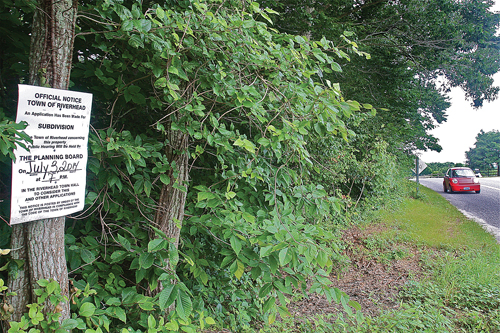27 new homes planned in Calverton

Twenty-seven new homes are being proposed for Youngs Avenue in Calverton, right next to the town landfill.
The preliminary subdivision application calls for residential lots averaging 30,000 square feet and two large areas of open space on a 51-acre site immediately west of the Riverhead Town landfill, which is no longer used for that purpose.
The Planning Board held a public hearing on the application last Thursday, during which there were no speakers other than the applicant’s attorney.
The planned subdivision, called Old Orchard at Baiting Hollow, actually goes back 25 years and was first proposed as a 45-lot subdivision by a previous owner in 1989.
The 51-acre site later became the subject of extensive litigation when the town Planning Board refused to exempt it from the townwide building moratorium that was in place during the town’s 2003 Master Plan update.
The property owner at that time, Joseph Manzi, maintained that his subdivision proposal met the town’s requirement for an exemption: that 70 percent of the land be preserved. However, the Planning Board argued that the proposed lots, each about 10,000 square feet, were too small and denied the exemption request, leading to lawsuits in both state and federal court.
The plan currently before the Planning Board is the result of a settlement of the federal civil rights lawsuit Mr. Manzi and his family filed against the town, according to Charles Cuddy, the applicant’s attorney.
“There are 27 dwelling units proposed and two large lots that will be preserved,” Mr. Cuddy said at last week’s public hearing. “The applicant would like to proceed with the subdivision as it is now. He had stopped proceeding because of the downturn in the market, which stopped everybody from building.”
Mr. Cuddy said the applicant has paid $140,000 in planning and building fees for the project.
The land is located in the Agricultural Protection Zone, which allows homes with minimum lot sizes of two acres. However, since the proposed subdivision is clustered to preserve the open space, the average size of the 27 residential lots is about 30,000 square feet, according to Mr. Cuddy.
The two open-space lots — about 310,000 square feet and 850,000 square feet respectively, according to the plan — together comprise 29 acres. The site is currently wooded and those open-space parcels will remain wooded, Mr. Cuddy said.
The Planning Board plans to discuss the application further at its July 17 work session.
One question board members will have to answer is whether the 27 lots called for in the settlement include the two open-space lots, according to a memo from town environmental planner Joe Hall.
If those lots are counted, it would make the project a 29-lot subdivision — two more lots than the settlement called for.
In addition to the landfill on its east, the 51-acre site abuts a 49-acre subdivision with 22 lots called Mastro Realty on the west.
Just west of that is The Preserve, a subdivision of about 25 lots that was built in the early 2000s.
In 2005, residents at The Preserve complained about odors coming from the town landfill. At the time, the town had a temporary asphalt plant there as part of the landfill reclamation project, which ended up being shut down due to cost overruns.
Since then, the landfill has been capped — a process that involves putting a large plastic cap over it — and closed, and the asphalt plant is long gone. The town still has methane and groundwater monitoring wells at the landfill site, and those issues concerned one board member last Thursday.
“In one of the staff reports, I noticed that there was a concern because of the close proximity of the landfill. Is there any more information on that?” Planning Board member Stan Carey asked.
He asked if there were still concerns about groundwater contamination or methane gas buildup from the landfill.
“If you start digging foundations, it could be a safety concern for these homes being so close to the landfill,” Mr. Carey said, referring to the possible presence of potentially explosive methane gases.
“The answer is yes, we looked at that and we didn’t see that it was a problem,” Mr. Cuddy replied.
Town planning department director Rick Hanley said the town has reports on file that deal with the possible migration of methane gas from the landfill.
The Town Board recently issued requests for proposals to build solar panels on some town properties, including the closed landfill. A decision about whether the landfill will be used for solar panels will be made by LIPA/PSEG-Long Island at the end of the year.
The town has also previously suggested using the closed landfill for walking trails, an idea that never got off the ground.






